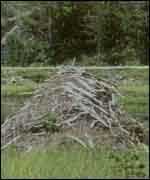
D-day for beaver
From BBC Scotland News March 7 th 2000
 Plans to re-introduce wild beaver to Scotland could take another step forward with the establishment of a pilot programme.
Plans to re-introduce wild beaver to Scotland could take another step forward with the establishment of a pilot programme.
Scottish Natural Heritage is considering the findings of a feasibility study which may result in the rodent's return and will decide on whether or not to approve an experimental release of beavers under controlled circumstances.
The study looked at the damage beavers would do, and whether they can co-exist with modern man.
Pelts valuable
Beavers were native to Scotland, but it is thought that the last one was killed by hunters about 400 years ago. At that time beaver pelts were valuable.
The European beaver is slightly smaller than the North American variety and is less prone to making big dams.
That should count in its favour when consideration is given to the potential damage to forestry.
A consultation by SNH in 1998 found that 86% of respondents were in favour of re-introduction.
Of those with a general interest - academics, naturalists, conservationists, ecologists, zoologists, and hillwalkers - 90% were in favour.
Best chance
Opposition to the plans came from anglers, farmers and fishermen.
There has been much talk in recent years of bringing back Scotland's lost wildlife.
The lynx, the wild boar and even the wolf have been discussed.
But of all the creatures which once occupied Scotland's landscape, the beaver seems to have the best chance of return.
© BBC Scotland News, 7 th March 2000
 |
 |
 |
| Return to index | Return to Exotic Scottish Animals | Return to European Beaver |